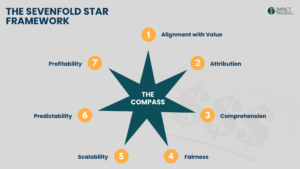Recall the first 4 columns of a value table are PSRV: Problem, Solution, Result, Value. This post focuses on the first column, Problem.
What problems does your product or service solve?
That’s what you will list in the problem column. This column has two very important functions. The first post on value tables boldly stated: “nobody cares about your product.” Guess what they do care about? Their problems. When you understand and talk to a buyer about their specific problems you demonstrate you understand them. They are more likely to listen to you. The first major purpose of the problem column is as marketing messages. This column contains a list of them.
The second critical function is to help you think more clearly about value. Eventually, you will put a dollar value on solving every problem. The more clearly you understand each problem, the more effectively you can quantify its value.
Problems
There are two steps to creating the problem column: listing problems and then re-writing them more specifically. First, list them. List as many as you can think of. Look at your marketable product features. For each one, why did you build it? I’m sure it was to solve a problem. List that problem (or problems). Think about different customers in different market segments. What problems did you solve for them? Over time you will think of more. Keep adding to the list as you think of them.
Problem statements have more impact when you use first person language. That forces you to put yourself in your buyer’s or customer’s shoes. You will see many examples later in this post.
Let’s use LinkedIn as an example. If you go to the LinkedIn website you will find lists of their marketable product features. These are features LinkedIn marketing people think are important enough to deserve mentioning in their marketing materials. These are what we call marketable product features. Let’s use just one of those features to drive our example. The feature: unlimited searching for people.
Solutions
In the solution column, we write “unlimited searching for people.” In the problem column, we write something like “I need to find somebody.” Makes sense. If we need to find somebody, we want to be able to search for them.” However, this isn’t specific enough. The next step in the problems column is to get more specific.
Instead of “I need to find somebody”, here are several possible more specific problems that feature solves:
-
I need to find more prospects to sell to.
-
I need to find a coauthor on a paper.
-
I need to find an expert in a field to ask questions.
-
I need to hire a new VP of Engineering.
-
I need to find the hiring manager for a position I’m applying for.
Although the same solution could solve each of these problems, you can see there is a very different value proposition for each one. There may be hundreds more of these. We want to list a representative sample of them and we especially want to be sure to capture the most valuable problems. Of the 5 problems listed, which do you think is the most valuable to solve? Second most valuable?
Working with clients on the problem column, it became apparent they had the “Curse of knowledge”. They had a hard time getting more specific. What worked was when they started thinking about specific customers. Why does this one customer use this one feature? You may find that approach helpful as well.
Something else that jumps out with these 5 problems. Different personas and market segments have different problems. At this point, go ahead and add a 5th column in your table and label it “who”. Then, in the column write in the personas and/or market segments that this problem applies to. You can have more than one in a cell. Here is what we might write in the “who” column for each of these problems in our LinkedIn example:
-
Salespeople, marketing people
-
Researchers, academics
-
Many people (maybe the problem isn’t specific enough yet.)
-
Human Resources, Hiring managers
-
Job seekers
Later, we will clean up the “who” section, but for now just list the people or market segments that obviously receive the most value from solving this problem. This gives you a place to capture information as you’re thinking about it.
Back to the two key reasons for the problem statements. First, marketing messages. Here are three different marketing messages you could deliver to Human Resources departments. Each one gets more specific.
-
Do you need unlimited searches for people?
-
Do you need to find somebody?
-
Do you need to find the right VP to hire?
Hopefully, you agree, the more specific, the more it resonates.
The second reason is value. It is very hard to put a value on the problem “I need to find people”. However, we could pretty easily put a dollar value on problems 1, 4, and 5 above, at least for a specific buyer.














